-
【linux】基础IO+系统文件IO+文件描述符分配规则
自我名言:只有努力,才能追逐梦想,只有努力,才不会欺骗自己。

喜欢的点赞,收藏,关注一下把!
1.重新谈论文件
根据前面所学知识,我们也了解一些文件的相关知识:
1.空文件,也要在磁盘占据空间
2.文件=文件内容+文件属性
3.文件操作=对内容+对属性 or 对内容和属性
4.标定一个文件,必须使用:文件路径+文件名【唯一性】
5.如果没有指定对应的文件路径,默认是在当前路径(进程当前的路径),进行访问6.当我们把fopen,fclose,fwrite,fread接口写完之后,代码编码之后,形成一个二进制可执行程序之后,但是没有运行,文件对应的操作有没有被执行?
其实并没有,对文件的操作,本质:进程对文件的操作!
7.一个文件如果没有被打开,可以直接进行文件访问吗?
不能,一个文件要被访问,必须先被打开。 那么被谁打开呢?
对文件的操作,是在进程中进行的,因此首先是用户进程,其次对文件操作的C接口是封装了系统调用接口,这部分是由OS操作的。
因此是由用户进程+OS共同进行的。
是不是所有文件都被打开呢?
不是,这里文件分成两类
a.被打开的文件
b.没有被打开的文件上述这么多知识都是为了阐明一点:
文件操作的本质:进程+被打开文件的关系2.重谈文件操作(C语言)
1.C,C++,Java,python…shell都有对文件操作的接口,但是接口都不一样
根据目前掌握的知识,了解文件在磁盘里,而磁盘是一个硬件,OS能访问硬件,因此所有人想访问磁盘都绕不过OS,使用的是OS提供的接口,想访问的是磁盘上的文件,因此使用的是OS提供文件级别的系统调用接口。所有语言访问文件接口五花八门,但是操作系统只有一个。
所以上层语言无论如何变化
a.库函数底层都必须调用系统调用接口
b.库函数可以千变万化,但是底层不变为了降低学习成本------->学习不变的东西
2.1C文件接口
2.文件的操作(C语言)
在C的时候学过文件相关操作知识,这里不再详细说,对这块知识记得不清的可以参考这篇博客超详细C语言文件操作,学完对文件了解更进一步。
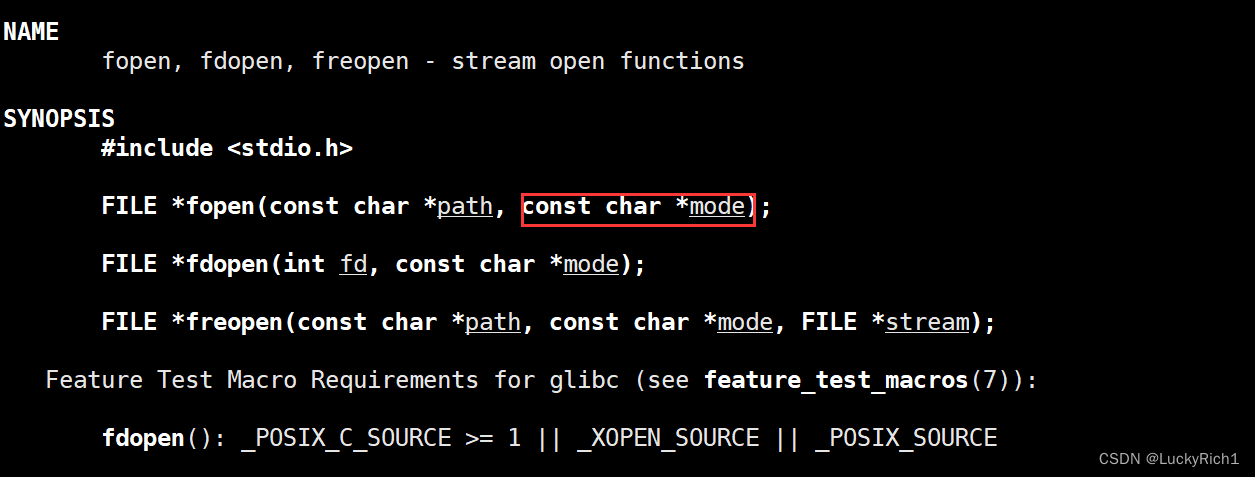
fopen打开文件,必须要提供打开的方式。这里总结一下r(读),w(写),
r+(读写,文件不存在报错),w+(读写,文件不存在创建),
a(append,追加),a+(在文件尾读写,文件不存在创建),
rb(读(二进制)),wb(写(二进制)),
rb+(读写(二进制),报错),wb+(读写(二进制),创建)
ab(二进制文件尾追加),ab+(二进制文件尾读写,创建)
写1 #include<stdio.h> 2 3 int main() 4 { 5 //打开 6 FILE* fp=fopen("log.txt","w"); 7 if(fp == NULL) 8 { 9 perror("fopen"); 10 return 1; 11 } 12 13 //写 14 int cnt=5; 15 while(cnt) 16 { 17 fprintf(fp,"%s:%d\n","hello linux",cnt--); 18 } 19 20 //关闭 21 fclose(fp); 22 return 0; 23 }- 1
- 2
- 3
- 4
- 5
- 6
- 7
- 8
- 9
- 10
- 11
- 12
- 13
- 14
- 15
- 16
- 17
- 18
- 19
- 20
- 21
- 22
- 23
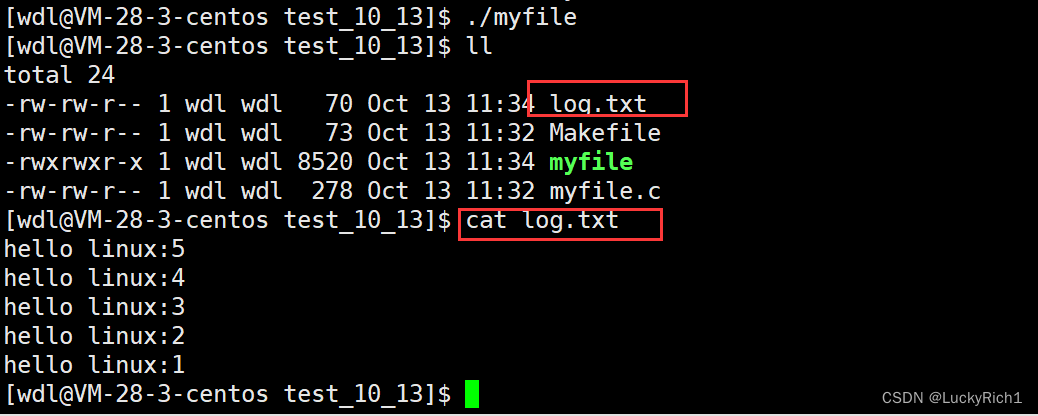
读1 #include<stdio.h> 2 #include<string.h> 3 4 int main() 5 { 6 //打开 7 // FILE* fp=fopen("log.txt","w"); 8 FILE* fp=fopen("log.txt","r"); 9 if(fp == NULL) 10 { 11 perror("fopen"); 12 return 1; 13 } 14 15 // //写 16 // int cnt=5; 17 // while(cnt) 18 // { 19 // fprintf(fp,"%s:%d\n","hello linux",cnt--); 20 // } 21 22 //读 23 char buffer[64]; 24 while(fgets(buffer,sizeof(buffer)-1,fp) != NULL) 25 { 26 buffer[strlen(buffer)-1]=0; 27 puts(buffer); 28 } 29 30 //关闭 31 fclose(fp); 32 return 0; 33 }- 1
- 2
- 3
- 4
- 5
- 6
- 7
- 8
- 9
- 10
- 11
- 12
- 13
- 14
- 15
- 16
- 17
- 18
- 19
- 20
- 21
- 22
- 23
- 24
- 25
- 26
- 27
- 28
- 29
- 30
- 31
- 32
- 33
- 34

追加1 #include<stdio.h> 2 #include<string.h> 3 4 int main() 5 { 6 //打开 7 // FILE* fp=fopen("log.txt","w"); 8 // FILE* fp=fopen("log.txt","r"); 9 FILE* fp=fopen("log.txt","a"); 10 if(fp == NULL) 11 { 12 perror("fopen"); 13 return 1; 14 } 15 16 //写 17 int cnt=5; 18 while(cnt) 19 { 20 fprintf(fp,"%s:%d\n","hello linux",cnt--); 21 } 22 23 // //读 24 // char buffer[64]; 25 // while(fgets(buffer,sizeof(buffer)-1,fp) != NULL) 26 // { 27 // buffer[strlen(buffer)-1]=0; 28 // puts(buffer); 29 // } 30 31 //关闭 32 fclose(fp); 33 return 0; 34 }- 1
- 2
- 3
- 4
- 5
- 6
- 7
- 8
- 9
- 10
- 11
- 12
- 13
- 14
- 15
- 16
- 17
- 18
- 19
- 20
- 21
- 22
- 23
- 24
- 25
- 26
- 27
- 28
- 29
- 30
- 31
- 32
- 33
- 34

以w方式单词的打开文件,C会自动清空内部数据1 #include<stdio.h> 2 #include<string.h> 3 4 int main() 5 { 6 //打开 7 FILE* fp=fopen("log.txt","w"); 8 // FILE* fp=fopen("log.txt","r"); 9 // FILE* fp=fopen("log.txt","a"); 10 if(fp == NULL) 11 { 12 perror("fopen"); 13 return 1; 14 } 15 16 // //写 17 // int cnt=5; 18 // while(cnt) 19 // { 20 // fprintf(fp,"%s:%d\n","hello linux",cnt--); 21 // } 22 23 // //读 24 // char buffer[64]; 25 // while(fgets(buffer,sizeof(buffer)-1,fp) != NULL) 26 // { 27 // buffer[strlen(buffer)-1]=0; 28 // puts(buffer); 29 // } 30 31 //关闭 32 fclose(fp); 33 return 0; 34 }- 1
- 2
- 3
- 4
- 5
- 6
- 7
- 8
- 9
- 10
- 11
- 12
- 13
- 14
- 15
- 16
- 17
- 18
- 19
- 20
- 21
- 22
- 23
- 24
- 25
- 26
- 27
- 28
- 29
- 30
- 31
- 32
- 33
- 34

这些都是C语言给我提供的一些对文件操作的接口。现在来看看OS给我们提供的关于对文件操作的系统调用的接口。
3.系统文件IO
3.1open

open有两个接口,首先来讲第二个接口

第一个参数:文件名
第三个参数:权限(如果创建一个文件,告诉系统该文件的权限是什么)
第二个参数:flags(是一个标记位,告诉系统以什么方式打开文件)

O_RDONLY(只读),O_WRONLY(只写),O_RDWR(读写)
flags有很多选项,这些选项是大写的,在我们印象中这样写都是宏。
C传标记位,一个int表示一个标记位,如果想传多个标记位怎么办呢?难道要传多个int吗?
显然这样处理不好。
正确解决方法:一个整数---->32个比特位---->通过比特位传递选项(一个比特位,一个选项,比特位位置不能重复)。1 #include<stdio.h> 2 #include<string.h> 3 4 //每一个宏,对应的数值,只有一个比特位是1,彼此位置不能重叠 5 #define ONE (1<<0) 6 #define TWO (1<<1) 7 #define THERE (1<<2) 8 #define FOUR (1<<3) 9 10 void show(int flags) 11 { 12 if(flags & ONE) printf("one\n"); 13 if(flags & TWO) printf("two\n"); 14 if(flags & THERE) printf("there\n"); 15 if(flags & FOUR) printf("four\n"); 16 } 17 18 int main() 19 { 20 21 show(ONE); 22 printf("------------------\n"); 23 show(ONE|TWO); 24 printf("------------------\n"); 25 show(ONE|TWO|THERE); 26 printf("------------------\n"); 27 show(ONE|TWO|THERE|FOUR); 28 printf("------------------\n"); 29 30 return 0; 31 }- 1
- 2
- 3
- 4
- 5
- 6
- 7
- 8
- 9
- 10
- 11
- 12
- 13
- 14
- 15
- 16
- 17
- 18
- 19
- 20
- 21
- 22
- 23
- 24
- 25
- 26
- 27
- 28
- 29
- 30
- 31
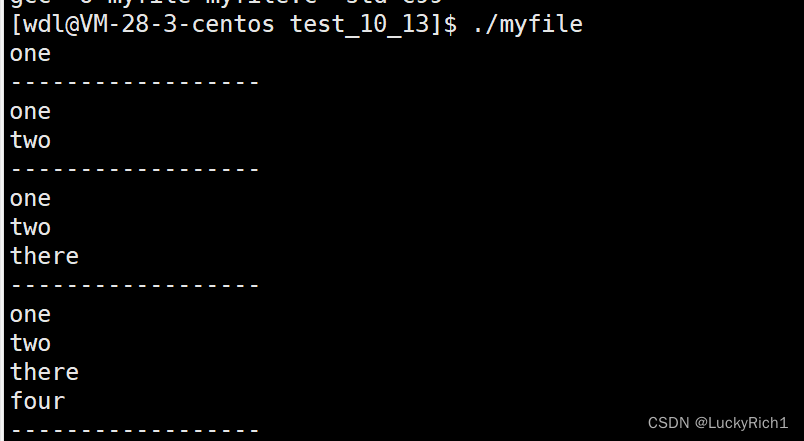
返回值:文件描述符(成功),-1(失败)

#include#include #include #include #include int main() { //打开 int fd=open("log.txt",O_WRONLY); if(fd<0) { perror("open"); return 1; } //关闭 close(fd); return 0; } - 1
- 2
- 3
- 4
- 5
- 6
- 7
- 8
- 9
- 10
- 11
- 12
- 13
- 14
- 15
- 16
- 17
- 18
- 19
- 20
- 21

文件不存在,并不会自动创建。这是因为我们调用C接口,是对底层的封装,然后让底层帮我们创建,但是现在我们直接用的就是底层,如果不给具体选项,是不会帮我们自动创建的。
#include#include #include #include #include int main() { //打开 //O_CREAT 创建 int fd=open("log.txt",O_WRONLY|O_CREAT); if(fd<0) { perror("open"); return 1; } //关闭 close(fd); return 0; } - 1
- 2
- 3
- 4
- 5
- 6
- 7
- 8
- 9
- 10
- 11
- 12
- 13
- 14
- 15
- 16
- 17
- 18
- 19
- 20
- 21
- 22

虽然成功创建了文件,但是这个文件权限和我们用C接口创建文件的权限是不一样的,这个是上面所说的原因一样,现在用的是系统调用接口,需要直接告诉这个文件权限是什么。#include#include #include #include #include int main() { //打开 int fd=open("log.txt",O_WRONLY|O_CREAT,0666); if(fd<0) { perror("open"); return 1; } //关闭 close(fd); return 0; } - 1
- 2
- 3
- 4
- 5
- 6
- 7
- 8
- 9
- 10
- 11
- 12
- 13
- 14
- 15
- 16
- 17
- 18
- 19
- 20
- 21


文件不存在,用的是有第三个参数的接口。
文件存在(已经有了权限),用的是没有第三个参数的接口。这里可能有个疑问。我给新创建的文件权限设置是0666,为什么新创建的文件权限权限是0664呢?
文件最终权限=起始权限(0666)&(~umask(普通用户0002))
所以新创建的文件权限是0664
那我们就想新创建的文件权限就是我们设置的权限怎么办呢?
umask(0)
清掉系统默认的umask
#include#include #include #include #include int main() { umask(0); //打开 int fd=open("log.txt",O_WRONLY|O_CREAT,0666); if(fd<0) { perror("open"); return 1; } //关闭 close(fd); return 0; } - 1
- 2
- 3
- 4
- 5
- 6
- 7
- 8
- 9
- 10
- 11
- 12
- 13
- 14
- 15
- 16
- 17
- 18
- 19
- 20
- 21

我们手动清楚了系统默认的umask,为什么这里还是0002呢?

注意,我们改掉的是子进程的权限,并不影响shell(还是0002)。3.2close

关闭文件。
参数就是文件描述符。3.3write

第一个参数:向那个文件里写
第二个参数:想写对应的缓冲区数据在哪里为什么第二个参数用的是void呢?
语言层面把文件类型分为:1,文本文件 。2,二进制文件。
但是操作系统一律认为都是二进制文件,所以是void第三个参数:缓冲区字节个数
返回值:成功时,写入内容的字节个数会被返回,失败时返回-1。

#include#include #include #include #include #include #include int main() { umask(0); //打开 int fd=open("log.txt",O_WRONLY|O_CREAT,0666); if(fd<0) { perror("open"); return 1; } //写 const char* buffer="hello linux\n"; ssize_t num= write(fd,buffer,strlen(buffer)); //向文件中写入string,strlen(buffer)+1 需要加1吗? //你以\0作为字符串的结尾,是C语言的规定,和我文件有什么关系呢? if(num<0) { perror("write"); exit(2); } //关闭 close(fd); return 0; } - 1
- 2
- 3
- 4
- 5
- 6
- 7
- 8
- 9
- 10
- 11
- 12
- 13
- 14
- 15
- 16
- 17
- 18
- 19
- 20
- 21
- 22
- 23
- 24
- 25
- 26
- 27
- 28
- 29
- 30
- 31
- 32
- 33
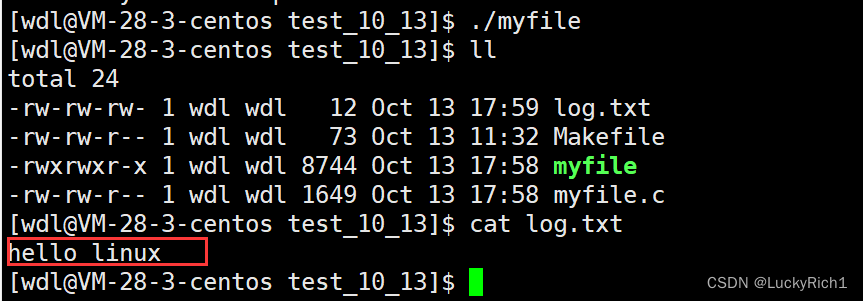
#include#include #include #include #include #include #include int main() { umask(0); //打开 int fd=open("log.txt",O_WRONLY|O_CREAT,0666); if(fd<0) { perror("open"); return 1; } //写 //const char* buffer="hello linux\n"; const char* buffer="aaaaaa\n"; ssize_t num= write(fd,buffer,strlen(buffer)); if(num<0) { perror("write"); exit(2); } //关闭 close(fd); return 0; } - 1
- 2
- 3
- 4
- 5
- 6
- 7
- 8
- 9
- 10
- 11
- 12
- 13
- 14
- 15
- 16
- 17
- 18
- 19
- 20
- 21
- 22
- 23
- 24
- 25
- 26
- 27
- 28
- 29
- 30
- 31
- 32
- 33

为什么是这样的结果呢?C语言以w方式打开文件,会先清空文件内容再写。
但是open(“log.txt”,O_WRONLY|O_CREAT,0666);只是直接覆盖,并不会清理。
这是因为我们少传一个参数O_TRUNC。#include#include #include #include #include #include #include int main() { umask(0); //打开 int fd=open("log.txt",O_WRONLY|O_CREAT|O_TRUNC,0666); if(fd<0) { perror("open"); return 1; } //写 //const char* buffer="hello linux\n"; const char* buffer="aaaaaa\n"; ssize_t num= write(fd,buffer,strlen(buffer)); if(num<0) { perror("write"); exit(2); } //关闭 close(fd); return 0; } - 1
- 2
- 3
- 4
- 5
- 6
- 7
- 8
- 9
- 10
- 11
- 12
- 13
- 14
- 15
- 16
- 17
- 18
- 19
- 20
- 21
- 22
- 23
- 24
- 25
- 26
- 27
- 28
- 29
- 30
- 31
- 32
- 33

以前我们C接口,fopen,以w/a方法打开文件,就是库里直接帮我们把下面工作做好了。

3.4read

第一个参数:从那个文件中读
第二个参数:读到那个缓冲区
第三个参数:读多少个字节
返回值:成功返回读取字节的个数,失败返回-1
#include#include #include #include #include #include #include int main() { umask(0); //打开 //bin int fd=open("log.txt",O_WRONLY|O_CREAT|O_TRUNC,0666); int fd=open("log.txt",O_RDONLY); if(fd<0) { perror("open"); return 1; } //读 char buffer[1024]; ssize_t num=read(fd,buffer,sizeof(buffer)-1); if(num > 0) buffer[num-1]=0; //0,\0,NULL--->0,,系统调用接口不管读的是什么类型文件,都会当作二进制处理,这里我们想读的是字符串,因此结尾加个\0 puts(buffer); //关闭 close(fd); return 0; } - 1
- 2
- 3
- 4
- 5
- 6
- 7
- 8
- 9
- 10
- 11
- 12
- 13
- 14
- 15
- 16
- 17
- 18
- 19
- 20
- 21
- 22
- 23
- 24
- 25
- 26
- 27
- 28
- 29
- 30

3.5lseek
重新定位读写文件的偏移量

这个函数和fseek类似,这里不再演示。3.6总结

4.如何理解文件
文件操作的本质:进程和被打开文件的关系。
进程可以打开多个文件吗?—>可以—>系统中一定会存在大量的被打开的文件 —>被打开打开的文件,要不要被OS管理起来呢?—>要 —> 如何管理?—> 先描述,在组织 —> 操作系统为了管理对应打开的文件,必定要为文件创建对应的内核数据结构标识文件 —>struct _file{ } —>包含了文件大部分属性。
#include#include #include #include #include #include #include #define FILE_NAME(number) "log.txt"#number int main() { umask(0); //打开 //int fd=open("log.txt",O_WRONLY|O_CREAT|O_TRUNC,0666); // int fd=open("log.txt",O_RDONLY); int fd0=open(FILE_NAME(1),O_WRONLY|O_CREAT|O_TRUNC,0666); int fd1=open(FILE_NAME(2),O_WRONLY|O_CREAT|O_TRUNC,0666); int fd2=open(FILE_NAME(3),O_WRONLY|O_CREAT|O_TRUNC,0666); int fd3=open(FILE_NAME(4),O_WRONLY|O_CREAT|O_TRUNC,0666); int fd4=open(FILE_NAME(5),O_WRONLY|O_CREAT|O_TRUNC,0666); printf("fd0:%d\n",fd0); printf("fd1:%d\n",fd1); printf("fd2:%d\n",fd2); printf("fd3:%d\n",fd3); printf("fd4:%d\n",fd4); close(fd0); close(fd1); close(fd2); close(fd3); close(fd4); return 0; } - 1
- 2
- 3
- 4
- 5
- 6
- 7
- 8
- 9
- 10
- 11
- 12
- 13
- 14
- 15
- 16
- 17
- 18
- 19
- 20
- 21
- 22
- 23
- 24
- 25
- 26
- 27
- 28
- 29
- 30
- 31
- 32
- 33
- 34
- 35

文件创建成功,并且返回各自对应的文件描述符。
但是奇怪的是:a.为什么从3开始呢?0,1,2去哪里了?
b.为什么是连续的小整数呢?—>什么会是连续的小整数呢?—> 猜测可能和数组有关这里就不得不提到,C程序默认会打开三个标准输入,标准输出,标准错误。

FILE* fp=fopen();问FILE是什么呢?
int fd=open(); int 是文件描述符我们知道C:fopen…是对底层系统调用接口的封装,而底层用的是文件描述符。
FILE是一个结构体 ----> 必须有一个字段存放文件描述
C调用文件函数的接口不仅对系统调用接口的封装,与此同时C语言FILE结构体也封装了操作系统内的文件描述符。

#include#include #include #include #include #include #include #define FILE_NAME(number) "log.txt"#number int main() { umask(0); printf("stdin->fd:%d\n",stdin->_fileno); printf("stdout->fd:%d\n",stdout->_fileno); printf("stderr->fd:%d\n",stderr->_fileno); //打开 //int fd=open("log.txt",O_WRONLY|O_CREAT|O_TRUNC,0666); // int fd=open("log.txt",O_RDONLY); int fd0=open(FILE_NAME(1),O_WRONLY|O_CREAT|O_TRUNC,0666); int fd1=open(FILE_NAME(2),O_WRONLY|O_CREAT|O_TRUNC,0666); int fd2=open(FILE_NAME(3),O_WRONLY|O_CREAT|O_TRUNC,0666); int fd3=open(FILE_NAME(4),O_WRONLY|O_CREAT|O_TRUNC,0666); int fd4=open(FILE_NAME(5),O_WRONLY|O_CREAT|O_TRUNC,0666); printf("fd0:%d\n",fd0); printf("fd1:%d\n",fd1); printf("fd2:%d\n",fd2); printf("fd3:%d\n",fd3); printf("fd4:%d\n",fd4); close(fd0); close(fd1); close(fd2); close(fd3); close(fd4); return 0; } - 1
- 2
- 3
- 4
- 5
- 6
- 7
- 8
- 9
- 10
- 11
- 12
- 13
- 14
- 15
- 16
- 17
- 18
- 19
- 20
- 21
- 22
- 23
- 24
- 25
- 26
- 27
- 28
- 29
- 30
- 31
- 32
- 33
- 34
- 35
- 36
- 37
- 38
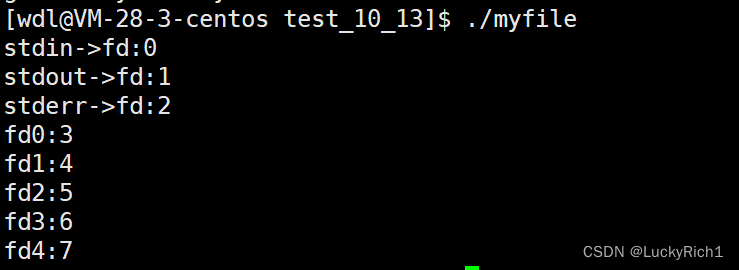
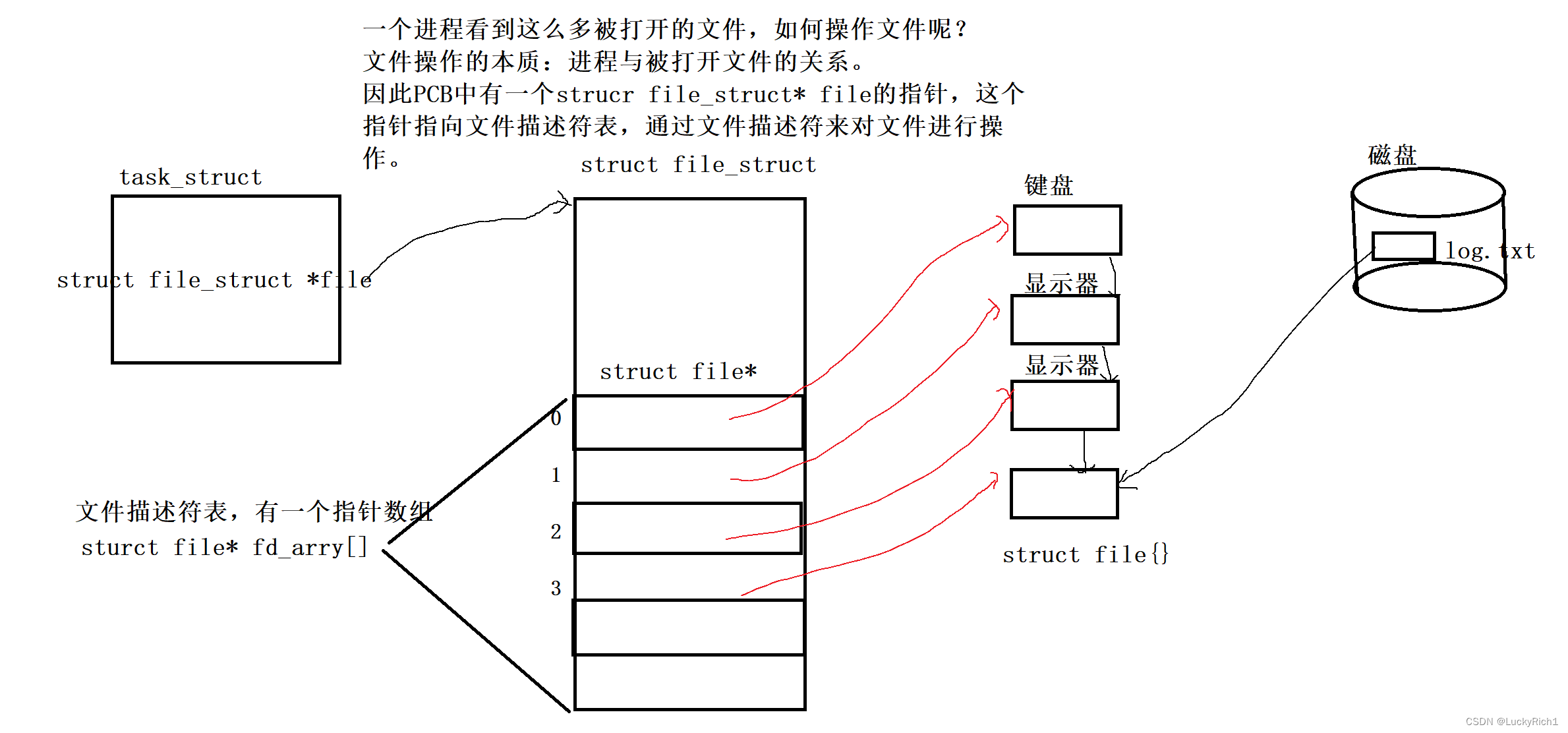
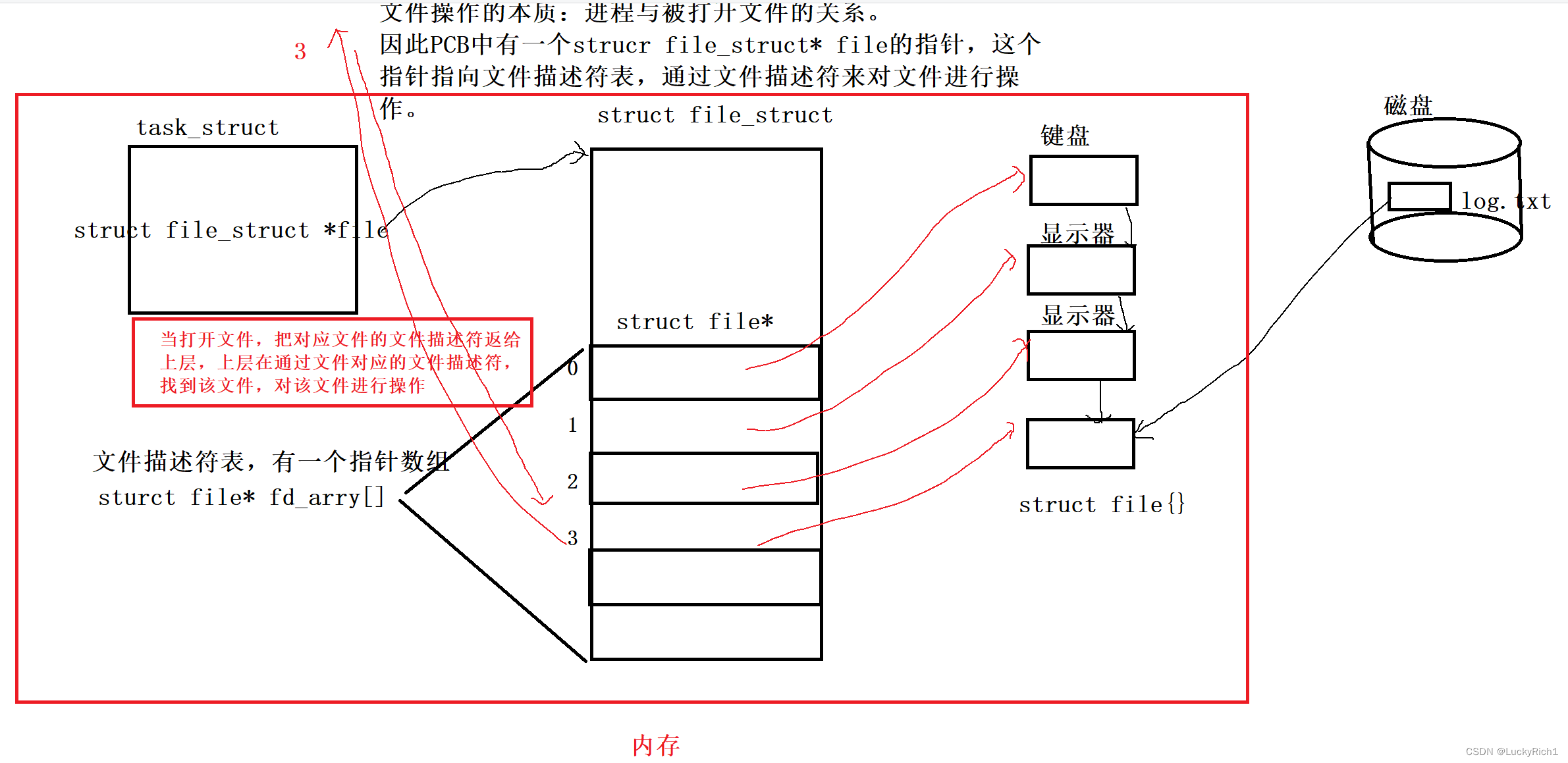
文件描述符的本质:就是数组的下标。进程与文件直之间对应的关系:进程通过文件描述符来指向文件的。
5.文件描述符(fd)分配规则
1 #include<stdio.h> 2 #include<string.h> 3 #include<sys/types.h> 4 #include<sys/stat.h> 5 #include<fcntl.h> 6 #include<unistd.h> 7 #include<stdlib.h> 8 9 int main() 10 { 11 umask(0); 12 int fd=open("log.txt",O_WRONLY|O_CREAT|O_TRUNC,0666); 13 if(fd == -1) 14 { 15 perror("open"); 16 exit(1); 17 } 18 printf("fd:%d\n",fd); 19 20 close(fd); 21 22 return 0; 23 }- 1
- 2
- 3
- 4
- 5
- 6
- 7
- 8
- 9
- 10
- 11
- 12
- 13
- 14
- 15
- 16
- 17
- 18
- 19
- 20
- 21
- 22
- 23

1 #include<stdio.h> 2 #include<string.h> 3 #include<sys/types.h> 4 #include<sys/stat.h> 5 #include<fcntl.h> 6 #include<unistd.h> 7 #include<stdlib.h> 8 9 int main() 10 { 11 close(0); 12 umask(0); 13 int fd=open("log.txt",O_WRONLY|O_CREAT|O_TRUNC,0666); 14 if(fd == -1) 15 { 16 perror("open"); 17 exit(1); 18 } 19 printf("fd:%d\n",fd); 20 21 close(fd); 22 23 return 0; 24 }- 1
- 2
- 3
- 4
- 5
- 6
- 7
- 8
- 9
- 10
- 11
- 12
- 13
- 14
- 15
- 16
- 17
- 18
- 19
- 20
- 21
- 22
- 23
- 24
- 25

1 #include<stdio.h> 2 #include<string.h> 3 #include<sys/types.h> 4 #include<sys/stat.h> 5 #include<fcntl.h> 6 #include<unistd.h> 7 #include<stdlib.h> 8 9 int main() 10 { 11 close(2); 12 umask(0); 13 int fd=open("log.txt",O_WRONLY|O_CREAT|O_TRUNC,0666); 14 if(fd == -1) 15 { 16 perror("open"); 17 exit(1); 18 } 19 printf("fd:%d\n",fd); 20 21 close(fd); 22 23 return 0; 24 }- 1
- 2
- 3
- 4
- 5
- 6
- 7
- 8
- 9
- 10
- 11
- 12
- 13
- 14
- 15
- 16
- 17
- 18
- 19
- 20
- 21
- 22
- 23
- 24
- 25

对比三次运行结果,发现每次创建新文件fd都不同,在仔细发现这是由于close(fd)关闭文件,所导致的结果。由图来解释上述原因
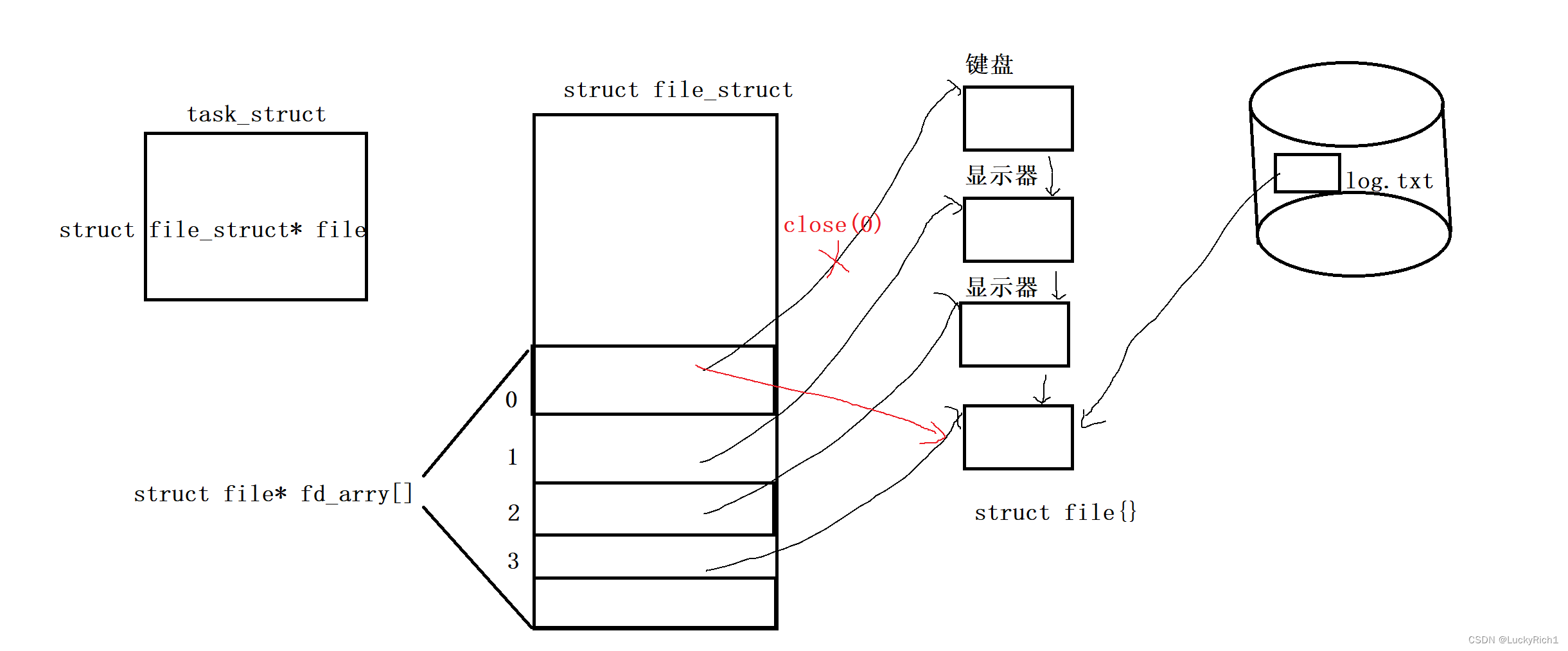
当我们关闭fd为0的文件,重新打开一个文件的时候,进程扫描文件描述符表:从小到大,按照循序寻找最小的且没有被占用的fd。(fd的分配规则)1 #include<stdio.h> 2 #include<string.h> 3 #include<sys/types.h> 4 #include<sys/stat.h> 5 #include<fcntl.h> 6 #include<unistd.h> 7 #include<stdlib.h> 8 9 int main() 10 { 11 // close(0); 12 // close(2); 13 close(1); 14 umask(0); 15 int fd=open("log.txt",O_WRONLY|O_CREAT|O_TRUNC,0666); 16 if(fd == -1) 17 { 18 perror("open"); 19 exit(1); 20 } 21 printf("fd:%d\n",fd); 22 23 close(fd); 24 25 return 0; 26 }- 1
- 2
- 3
- 4
- 5
- 6
- 7
- 8
- 9
- 10
- 11
- 12
- 13
- 14
- 15
- 16
- 17
- 18
- 19
- 20
- 21
- 22
- 23
- 24
- 25
- 26

close(1),为什么没有打印新建文件fd呢?
printf(“%d\n”,fd); printf会把内容打印到stdout文件中。
但是close(1)关闭标准输出stdout—>显示器,int fd=open();新打开的文件fd是1。
stdout–>fd–>1,虽然我们手动关闭了stdout,但是系统并不知道,还以为fd为1的位置是stdout,但是这个位置现在已经被新打开的文件占用了,所以打印到了新打开的文件里。1 #include<stdio.h> 2 #include<string.h> 3 #include<sys/types.h> 4 #include<sys/stat.h> 5 #include<fcntl.h> 6 #include<unistd.h> 7 #include<stdlib.h> 8 9 int main() 10 { 11 // close(0); 12 // close(2); 13 close(1); 14 umask(0); 15 int fd=open("log.txt",O_WRONLY|O_CREAT|O_TRUNC,0666); 16 if(fd == -1) 17 { 18 perror("open"); 19 exit(1); 20 } 21 printf("fd:%d\n",fd); 22 23 //这里必须刷新一下,不然log.txt里面没有内容,这里和缓冲区有关,下面讲 24 fflush(stdout); 25 close(fd); 26 27 return 0; 28 }- 1
- 2
- 3
- 4
- 5
- 6
- 7
- 8
- 9
- 10
- 11
- 12
- 13
- 14
- 15
- 16
- 17
- 18
- 19
- 20
- 21
- 22
- 23
- 24
- 25
- 26
- 27
- 28

本来应该打印到显示器文件中,但是确写到文件里了。------>重定向
有关重定向问题,下篇博文解释!
-
相关阅读:
ensp实操浮动静态路由
springboot banner.txt文件
Qt地铁智慧换乘系统浅学(四 )实现添加线路,添加站点,添加边 并且存储到本地txt文件
springboot 老年人健康保障管理系统毕业设计源码302303
说透缓存一致性与内存屏障
java开发IP 属地功能
002从零开始入门Entity Framework Core——DbContext生存期、配置和初始化
java毕业设计课程作业管理系统mybatis+源码+调试部署+系统+数据库+lw
webservice初探
Python作业【简单算法题】
- 原文地址:https://blog.csdn.net/fight_p/article/details/133804670
